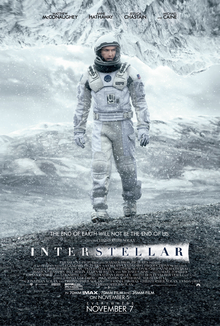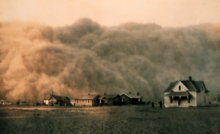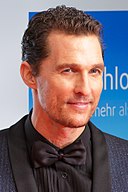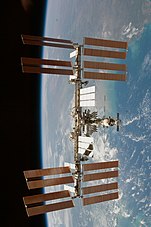Interstellar movie
From Wikipedia, the free encyclopedia
Interstellar Theatrical release poster
Theatrical release poster
- Directed byChristopher NolanWritten byJonathan Nolan
- Christopher Nolan
- Produced byEmma Thomas
- Christopher Nolan
- Lynda Obst
- StarringMatthew McConaughey
- Anne Hathaway
- Jessica Chastain
- Bill Irwin
- Ellen Burstyn
- Michael Caine
CinematographyHoyte van HoytemaEdited byLee SmithMusic byHans ZimmerProduction
- companiesParamount Pictures
- Warner Bros. Pictures
- Legendary Pictures
- Syncopy
- Lynda Obst Productions
- Distributed byParamount Pictures (North America)
- Warner Bros. Pictures (International)
- Release datesOctober 26, 2014 (TCL Chinese Theatre)
- November 5, 2014 (United States)
- November 7, 2014 (United Kingdom)
- Running time169 minutes[1]CountriesUnited Kingdom[2]
- United States[2]
LanguageEnglishBudget$165 million[3]Box office$731 million[3]
Interstellar is a 2014 epic science fiction film co-written, directed, and produced by Christopher Nolan. It stars Matthew McConaughey, Anne Hathaway, Jessica Chastain, Bill Irwin, Ellen Burstyn, Michael Caine, and Matt Damon. Set in a dystopian future where humanity is embroiled in a catastrophic blight and famine, the film follows a group of astronauts who travel through a wormhole near Saturn in search of a new home for humankind.
Brothers Christopher and Jonathan Nolan wrote the screenplay, which had its origins in a script Jonathan developed in 2007 and was originally set to be directed by Steven Spielberg. Kip Thorne, a Caltech theoretical physicist and 2017 Nobel laureate in Physics,[4] was an executive producer, acted as a scientific consultant, and wrote a tie-in book, The Science of Interstellar. Cinematographer Hoyte van Hoytema shot it on 35 mm movie film in the Panavision anamorphic format and IMAX 70 mm. Principal photography began in late 2013 and took place in Alberta, Iceland, and Los Angeles. Interstellar uses extensive practical and miniature effects, and the company Double Negative created additional digital effects.
Interstellar premiered in Los Angeles on October 26, 2014. In the United States, it was first released on film stock, expanding to venues using digital projectors. The film received positive reviews from critics and grossed over $681 million worldwide ($703 million after subsequent re-releases), making it the tenth-highest-grossing film of 2014. It has been praised by astronomers for its scientific accuracy and portrayal of theoretical astrophysics.[5][6][7] Interstellar was nominated for five awards at the 87th Academy Awards, winning Best Visual Effects, and received numerous other accolades.
Plot[edit]
In the near future, humanity is facing extinction following a global famine caused by ecocide.[8] Cooper's family, which includes his children, Tom and Murph, and his father-in-law Donald, survive by pursuing farming, much like most of humanity. One evening after a dust storm, Cooper discovers a gravitational anomaly inside Murph's bedroom, which creates patterns of falling particles. The pattern resolves into GPS coordinates, which leads Cooper and Murph to a secret NASA facility.
NASA is believed to have shut down but continues to operate, its latest mission being to find a habitable planet beyond the solar system. A team is preparing to travel through a wormhole near Saturn, leading to a faraway galaxy that has three potentially habitable planets, each orbiting the supermassive blackhole called Gargantua. Cooper is asked by Dr Brand, the lead scientist, to pilot the crew due to past experience. Cooper struggles to leave behind Murph, but agrees after promising her to return. Murph acts cold towards Cooper, and refuses to say goodbye. The Endurance spacecraft takes off with three other NASA scientists − Romilly, Doyle and Brand's daughter Amelia − as well as two intelligent robots, TARS and CASE.
Past the wormhole, the crew arrive at the first planet, an ocean world with massive tidal waves. Doyle is swept away within minutes, but Cooper and Amelia survive a round of waves to return to the Endurance. Though they were only gone a few hours, they find that 23 years have passed due to time dilation. Back on Earth, an adult Murph, who is still mad at Cooper, is helping Dr Brand formulate an equation to solve the problem of mass exodus — transporting Earth's population off the planet while escaping its gravity. On his deathbed, Brand reveals that the equation is unsolvable. Murph is left alone to continue his work and turns to her childhood bedroom as the source of the initial anomaly, to look for clues. She comes across the wrist-watch Cooper gave her before he left on her bookshelf.
On the second planet, the crew find the planet's previous NASA explorer, Dr Mann, still alive and in cryostasis. They awaken him, and learn that the planet has positive data linked to habitability. On a scouting mission, however, Mann confesses to having lied so that someone might come and rescue him from the ice-world planet. He sets off a chain of events that results in Romilly's death. He takes the Endurance crew's lander and attempts to seize control of the Endurance. However, TARS removed his clearance to successfully do so, but Mann persists. This attempt leads to his death and a portion of Endurance exploding. Cooper and Amelia regain control of the craft, but, with limited resources, must chart a gravity-assist path around Gargantua to propel the craft to the third planet. At the last moment, Cooper detaches himself and TARS so that Amelia may reach the final planet safely. He and TARS fall beyond the black hole's event horizon.
Inside, Cooper and TARS find a mysterious five-dimensional tesseract where time is a physical dimension. Cooper is able to use gravity to communicate with his past self, and realizes he sent himself the NASA coordinates, initiating this mission. He realizes that the goal is to feed Murph the blackhole gravity-data to help her solve the equation, and encodes the data into the ticking pattern of his wristwatch. Murph finds the watch on her visit there and uses it to solve Brand's equation. The tesseract dissolves, ejecting Cooper and TARS through the wormhole and into Saturn's orbit again, where a present-day (22nd century CE) space-faring O'Neill cylinder picks them up.
Cooper awakens inside a hospital and is reunited with an aging Murph, who is now considerably older than him. Murph asks that Cooper leave her and instead find Amelia. Cooper and TARS set off for the third planet, where Amelia is directing the setup of a new colony in the planet's desert-like environment. Alone on the habitable planet, she takes off her helmet and breathes in the air.
Cast[edit]
Matthew McConaughey and Anne Hathaway played the protagonists of Interstellar.
- Matthew McConaughey as Joseph Cooper,[a] a widowed NASA pilot who, after the agency was closed by the government, became a farmer
- Anne Hathaway as Dr. Amelia Brand, a NASA scientist, astronaut, and Professor Brand's daughter
- Jessica Chastain as Murphy "Murph" Cooper, Joseph's daughter, who eventually becomes a NASA scientist
- Mackenzie Foy as young Murph
- Ellen Burstyn as elderly Murph
- Bill Irwin as TARS (voice and puppetry) and CASE (puppetry)
- Michael Caine as Professor John Brand, a high-ranking NASA scientist, ideator of Plan A, former mentor of Cooper, and father of Amelia
- John Lithgow as Donald, Cooper's elderly father-in-law
- David Gyasi as Professor Romilly, a high-ranking NASA member, and Endurance crew member
- Wes Bentley as Doyle, another high-ranking NASA member, and Endurance crew member
- Casey Affleck as Tom Cooper, Joseph's son, who eventually grows up to become a farmer
- Timothée Chalamet as young Tom
- Matt Damon as Dr. Mann, a NASA astronaut sent to an icy planet during the Lazarus program
- Josh Stewart as CASE (voice)
- Topher Grace as Getty, Murph's colleague and love interest
- Leah Cairns as Lois, Tom's wife
- David Oyelowo as School Principal
- Collette Wolfe as Ms. Hanley
- William Devane as Williams, another NASA member
- Elyes Gabel as Administrator
- Jeff Hephner as Doctor
Production[edit]
Crew[edit]
- Christopher Nolan – Director, producer, writer
- Jonathan Nolan – Writer
- Emma Thomas – Producer
- Lynda Obst – Producer
- Hoyte van Hoytema – Cinematographer
- Nathan Crowley – Production designer
- Mary Zophres – Costume designer
- Lee Smith – Editor
- Hans Zimmer – Music composer
- Paul Franklin – Visual effects supervisor
- Kip Thorne – Consultant, executive producer
Development and financing[edit]
The premise for Interstellar was conceived by the producer Lynda Obst and the theoretical physicist Kip Thorne, who collaborated on the film Contact (1997), and had known each other since Carl Sagan set them up on a blind date.[9][10] The two conceived a scenario, based on Thorne's work, about "the most exotic events in the universe suddenly becoming accessible to humans", and attracted Steven Spielberg's interest in directing.[11] The film began development in June 2006, when Spielberg and Paramount Pictures announced plans for a science-fiction film based on an eight-page treatment written by Obst and Thorne. Obst was attached to produce.[12][13] By March 2007, Jonathan Nolan was hired to write a screenplay.[14]
After Spielberg moved his production studio, DreamWorks, from Paramount to Walt Disney Studios in 2009, Paramount needed a new director for Interstellar. Jonathan Nolan recommended his brother Christopher, who joined the project in 2012.[15] Christopher Nolan met with Thorne, then attached as executive producer, to discuss the use of spacetime in the story.[16] In January 2013, Paramount and Warner Bros. announced that Christopher Nolan was in negotiations to direct Interstellar.[17] Nolan said he wanted to encourage the goal of human spaceflight,[18] and intended to merge his brother's screenplay with his own.[19] By the following March, Nolan was confirmed to direct Interstellar, which would be produced under his label Syncopy and Lynda Obst Productions.[20] The Hollywood Reporter said Nolan would earn a salary of $20 million against 20% of the total gross.[21] To research for the film, Nolan visited NASA and the private space program at SpaceX.[16]
Warner Bros. sought a stake in Nolan's production of Interstellar from Paramount, despite their traditional rivalry, and agreed to give Paramount its rights to co-finance the next film in the Friday the 13th horror franchise, with a stake in a future film based on the television series South Park. Warner Bros. also agreed to let Paramount co-finance an indeterminate "A-list" property.[22] In August 2013, Legendary Pictures finalized an agreement with Warner Bros. to finance approximately 25% of the film's production. Although it failed to renew its eight-year production partnership with Warner Bros., Legendary reportedly agreed to forgo financing Batman v Superman: Dawn of Justice (2016) in exchange for the stake in Interstellar.[23]
Writing and casting[edit]
 The Dust Bowl phenomenon of the 1930s, as documented by Ken Burns in The Dust Bowl (2012), served as inspiration for the blight.
The Dust Bowl phenomenon of the 1930s, as documented by Ken Burns in The Dust Bowl (2012), served as inspiration for the blight.
Jonathan Nolan worked on the script for four years.[9] To learn the scientific aspects, he studied relativity at the California Institute of Technology.[24] He was pessimistic about the Space Shuttle program ending and how NASA lacked financing for a human mission to Mars, drawing inspiration from science-fiction films with apocalyptic themes, such as WALL-E (2008) and Avatar (2009). Jeff Jensen of Entertainment Weekly said: "He set the story in a dystopian future ravaged by blight, but populated with hardy folk who refuse to bow to despair."[15] His brother Christopher had worked on other science fiction scripts but decided to take the Interstellar script and choose among the vast array of ideas presented by Jonathan and Thorne. He picked what he felt, as director, he could get "across to the audience and hopefully not lose them," before he merged it with a script he had worked on for years on his own.[16][25] Christopher kept in place Jonathan's conception of the first hour, which is set on a resource depleted Earth in the near future. The setting was inspired by the Dust Bowl that took place in the United States during the Great Depression in the 1930s.[9] He revised the rest of the script, where a team travels into space, instead.[9] After watching the 2012 documentary The Dust Bowl for inspiration, Christopher contacted the director, Ken Burns, and the producer, Dayton Duncan. They granted him permission to use some of their featured interviews in Interstellar.[26]
Christopher Nolan wanted an actor who could bring to life his vision of the main character as an everyman with whom "the audience could experience the story."[27] He became interested in casting Matthew McConaughey after watching him in an early cut of the 2012 film Mud,[27] which he had seen as a friend of one of its producers, Aaron Ryder.[9] Nolan went to visit McConaughey while he was filming for the TV series True Detective.[28] Anne Hathaway was invited to Nolan's home, where she read the script for Interstellar.[29] In early 2013, both actors were cast in the starring roles.[30] Jessica Chastain was contacted while she was working on Miss Julie (2014) in Northern Ireland, and a script was delivered to her.[29] Originally, Irrfan Khan was offered the role of Dr. Mann but rejected it due to scheduling conflicts. Matt Damon was cast as Mann in late August 2013 and completed filming his scenes in Iceland.[31]
Principal photography[edit]
Nolan shot Interstellar on 35 mm film in the Panavision anamorphic format and IMAX 70 mm photography.[32] Cinematographer Hoyte van Hoytema was hired for Interstellar, as Wally Pfister, Nolan's cinematographer on all of his previous films, was making his directorial debut working on Transcendence (2014);[33] Pfister would later retire as a cinematographer for films.[34] More IMAX cameras were used for Interstellar than for any of Nolan's previous films. To minimize the use of computer-generated imagery (CGI), Nolan had practical locations built, such as the interior of a space shuttle.[27] Van Hoytema retooled an IMAX camera to be hand-held for shooting interior scenes.[9] Some of the film's sequences were shot with an IMAX camera installed in the nose cone of a Learjet.[35] Nolan, who is known for keeping details of his productions secret, strove to ensure secrecy for Interstellar. Writing for The Wall Street Journal, Ben Fritz stated, "The famously secretive filmmaker has gone to extreme lengths to guard the script to ... Interstellar, just as he did with the blockbuster Dark Knight trilogy."[36] As one security measure, Interstellar was filmed under the name Flora's Letter,[37] Flora being one of Nolan's four children with producer Emma Thomas.[16]
The film's principal photography was scheduled to last four months.[31] It began on August 6, 2013, in the province of Alberta, Canada.[23] Towns in Alberta where shooting took place included Nanton, Longview, Lethbridge, Fort Macleod, and Okotoks. In Okotoks, filming took place at the Seaman Stadium and the Olde Town Plaza.[37] For a cornfield scene, production designer Nathan Crowley planted 500 acres (200 ha) of corn that would be destroyed in an apocalyptic dust storm scene,[15] intended to be similar to storms experienced during the Dust Bowl in 1930s America.[16] Additional scenes involving the dust storm and McConaughey's character were also shot in Fort Macleod, where the giant dust clouds were created on location using large fans to blow cellulose-based synthetic dust through the air.[38] Filming in the province lasted until September 9, 2013, and involved hundreds of extras in addition to 130 crew members, most of whom were local.[37]
Shooting also took place in Iceland, where Nolan had previously filmed scenes for Batman Begins (2005).[39] It was chosen to represent two extraterrestrial planets: one covered in ice, and the other in water.[9] The crew transported mock spaceships weighing about 10,000 pounds (4,500 kg).[16] They spent two weeks shooting there,[31] during which a crew of about 350 people, including 130 locals, worked on the film. Locations included the Svínafellsjökull glacier and the town of Klaustur.[40][41] While filming a water scene in Iceland, Hathaway almost suffered hypothermia because her dry suit had not been properly secured.[16]
After the schedule in Iceland was completed, the crew shot in Los Angeles for 54 days. Filming locations included the Westin Bonaventure Hotel and Suites, the Los Angeles Convention Center, a Sony Pictures soundstage in Culver City, and a private residence in Altadena, California.[42] Principal photography concluded in December 2013.[43] Production had a budget of $165 million, $10 million less than was allotted by Paramount, Warner Bros., and Legendary Pictures.[16]
Production design[edit]
The Endurance spacecraft (left) is based on the International Space Station (right).
Interstellar features three spacecraft— the Endurance, a ranger, and a lander. The Endurance, the crew's mother ship, is a circular structure consisting of 12 capsules, laid flat to mimic a clock: Four capsules with planetary settling equipment, four with engines, and four with the permanent functions of cockpit, medical labs, and habitation. Production designer Nathan Crowley said the Endurance was based on the International Space Station: "It's a real mish-mash of different kinds of technology. You need analogue stuff, as well as digital stuff, you need backup systems and tangible switches. It's really like a submarine in space. Every inch of space is used, everything has a purpose." The ranger's function is similar to the Space Shuttle's, being able to enter and exit planetary atmospheres. Lastly, the lander transports the capsules with settling equipment to planetary surfaces. Crowley compared it to "a heavy Russian helicopter."[9]
The film features two robots, CASE and TARS, as well as a dismantled third robot, KIPP. Nolan wanted to avoid making the robots anthropomorphic and chose a 1.5 m (4.9 ft) quadrilateral design. He said: "It has a very complicated design philosophy. It's based on mathematics. You've got four main blocks and they can be joined in three ways. So, you have three combinations you follow. But then within that, it subdivides into a further three joints. And all the places we see lines—those can subdivide further. So you can unfold a finger, essentially, but it's all proportional." Bill Irwin voiced and physically controlled both robots, with his image digitally removed, and Josh Stewart replaced his voicing for CASE.[9] The human space habitats resemble O'Neill cylinders, a theoretical space habitat model proposed by physicist Gerard K. O'Neill in 1976.[44]
Sound design[edit]
Gregg Landaker and Gary Rizzo were the film's audio engineers tasked with audio mixing, while sound editor Richard King supervised the process.[45] Christopher Nolan sought to mix the sound to take maximum advantage of theater equipment[46] and paid close attention to designing the sound mix, like focusing on the sound of buttons being pressed with astronaut suit gloves.[15] The studio's website stated that the film was "mixed to maximize the power of the low-end frequencies in the main channels, as well as in the subwoofer channel."[47] Nolan deliberately intended some dialogue to seem drowned out by ambient noise or music, causing some theaters to post notices emphasizing that this effect was intentional and not a fault in their equipment.[48]
Music[edit]
Main article: Interstellar (soundtrack)
Hans Zimmer, who scored Nolan's The Dark Knight Trilogy and Inception (2010), returned to score Interstellar. Nolan chose not to provide Zimmer with a script or any plot details but instead gave him a single page that told the story of a father leaving his child for work. It was through this connection that Zimmer created the early stages of the Interstellar soundtrack. Zimmer and Nolan later decided the 1926 four-manual Harrison & Harrison organ of the Temple Church, London, would be the primary instrument for the score.[49][50] Zimmer conducted 45 scoring sessions for Interstellar, three times more than for Inception. The soundtrack was released on November 18, 2014.[15]




























